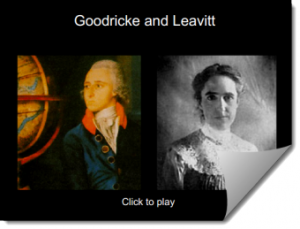Cepheid stars: Difference between revisions
No edit summary |
No edit summary |
||
| (2 intermediate revisions by the same user not shown) | |||
| Line 25: | Line 25: | ||
|other= | |other= | ||
|resources= | |resources= | ||
The presentation has been converted to | The presentation has been converted to a number of different formats. You can download | ||
* Various different formats (with audio explanation) in one ZIP file: {{file|SC0036 Cepheid Stars.zip}} | |||
Or you can download the files individually: | |||
* Powerpoint version:{{file| SC0036 Cepheid stars.ppt }} | * Powerpoint version:{{file| SC0036 Cepheid stars.ppt }} | ||
* Audio explanation [[media: ]] | <!-- * Audio explanation [[media: ]] --> | ||
* Teacher's audio explanation of how the lesson was delivered | * Teacher's audio explanation of how the lesson was delivered {{File|CT - Cepheid voiceover.MP3}} | ||
* Smartboard notebook version | * Smartboard notebook version {{File|Cepheid stars.notebook}} | ||
* Powerpoint with details about the astronomers, Goodriche & Leavitt: | <!-- * Powerpoint with details about the astronomers, Goodriche & Leavitt: {{File|SC0036 Cepheid stars.ppt}} --> | ||
* PDF preview version | * PDF preview version {{File|SC0036 Cepheid stars.pdf}} | ||
{{Astronomy presentations dropbox}} | |||
}} | }} | ||
Latest revision as of 11:34, 5 January 2015
Astronomy - presentations
[[|<<<]]
[[|>>>]]
This resource may not be final.
Lesson idea. This is the third and final slide presentation lesson of a series on the calculation of the distances of stars. Traditionally a challenging lesson for students, this takes a step by step approach. The teacher provides (The next lesson considers how we know about the chemistry and characteristics of stars).
Teaching approach. The lesson model is that of active note-making. Students are provided with mini-diagrams* around which they build up personalised notes about the lesson. Students must not take notes from the board but instead must use their creativity to develop their own notes. They are encouraged to use colour, image, symbols, humour and metaphor to lead them through a richer learning experience. Students need help in achieving this but soon catch onto the idea. They become more independent with taking notes and more attentive to the subject at hand. (edit)
| Resource details | |
| Title | Cepheid stars |
| Topic | |
| Teaching approach | |
| Learning Objectives |
|
| Format / structure | |
| Subject | |
| Age of students / grade | |
| Table of contents | |
| Additional Resources/material needed | |
| Useful information | |
| Related ORBIT Wiki Resources | Read the Wikipedia article on Henrietta Leavitt |
| Other (e.g. time frame) | |
| Files and resources to view and download | The presentation has been converted to a number of different formats. You can download
Or you can download the files individually:
Alternative download: https://www.dropbox.com/sh/3ehh21bjv85yiym/AAD_jmQiqKIQu8TUvHepVQTna?dl=0 |
| Acknowledgement | |
| License | |

